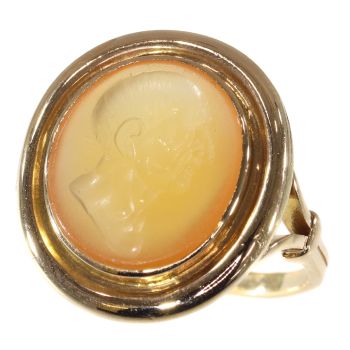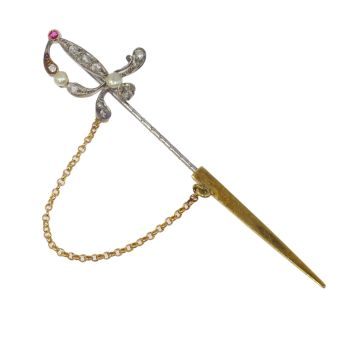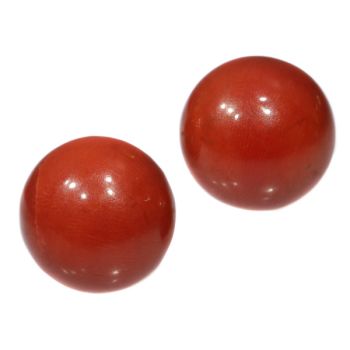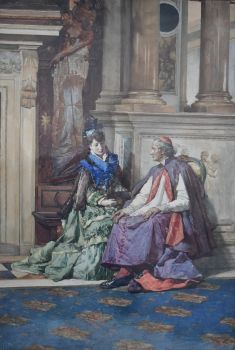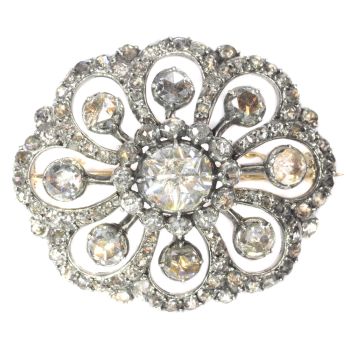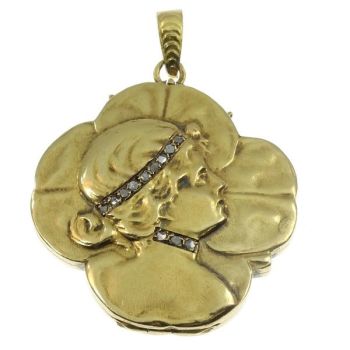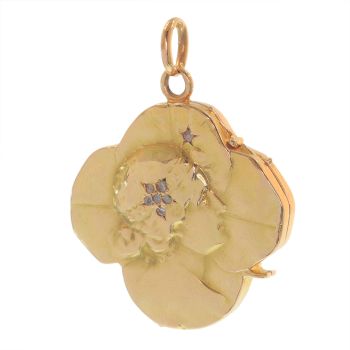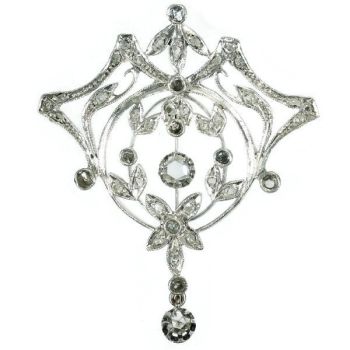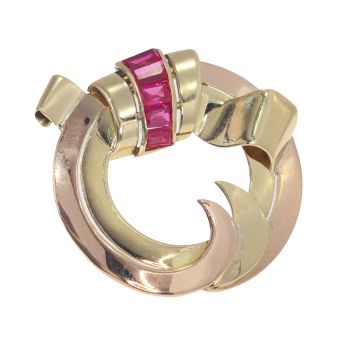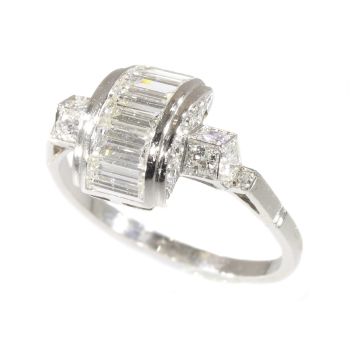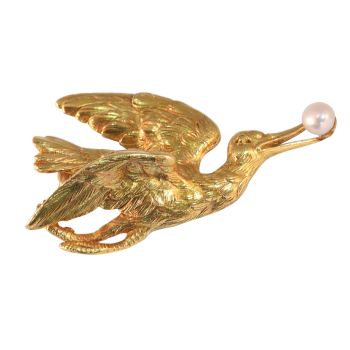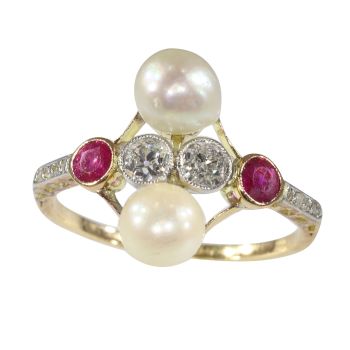Spilla-ciondolo con diamanti del primo periodo vittoriano medaglione grande cabochon a forma di cuor 1830
Artista Sconosciuto
DiamanteRubinoOroPietra preziosa
€ 19.000
Adin Fine Antique Jewellery
- A proposito di opere d'arte
This Early-Victorian bi-colour gold-backed pendant from 1830 embodies a treasure of symbols through a deep pink garnet heart, a silver-topped bow, snake, cross and anchor encrusted with three European cut diamonds and with a total of 86 rose cut diamonds set in foil.
While the ruby-eyed snake wraps around the cross, its head emerges to the centre of the garnet and emphasizes the opulent heart-shape. This meaningful composition reveals the snake's role of protection, wisdom, hope and fertility when it comes to matters of the heart from deep within the garnet's core.
This gemstone of love is topped by a cross which extends from behind the garnet into an anchor, resulting in an Anchored cross or also called a Mariner's cross. Generally signifying hope, this bejeweled imagery contributes even more to the message ofpromise and faith in this jewel.
To complete the message of hope and tenderness, the above-mentioned piece with a 14K yellow gold back dangles from an adorable bow-knot with an 18K red gold back which literally depicts the strong bond of love. This bow particulalry grants you thepossiblity to even wear this extraordinary jewellery piece as a brooch.
For more information, please look below at the chapter with "Extra information".It couldn't be more clear from the craftsmanship and the total design that this jewel doesn't just speak of promises and fairytales, but it truly achieves to convey the message of love.
Antique jewelry object group: combined brooch-pendant (the pendant can be taken from the bow, so both can be worn seperately too.
Condition: excellent condition
- (more info on our condition scale)
Country of origin:unknown (although from the same period, the bow is silver with 18K gold, and the pendant is silver with 14K gold)
Style: Early-Victorian - Victorian decorative arts refers to the style of decorative arts during the Victorian era. The Victorian era is known for its eclectic revival and interpretation of historic styles and the introduction of cross-cultural influencesfrom the middle east and Asia in furniture, fittings, and Interior decoration. Victorian design is widely viewed as having indulged in a regrettable excess of ornament. The Arts and Crafts movement, the aesthetic movement, Anglo-Japanese style, and ArtNouveau style have their beginnings in the late Victorian era.
- See also: early-Victorianor more info on styles
Style specifics: The Romantic Victorian Period - Experts divide the reign of Queen Victoria, also called The Victorian era (1837 - 1901) in to three periods of about twenty years each; The Romantic Victorian Period (1837 - 1860), The Grand Victorian Period (1860 -1880), and the Late or Aesthetic Victorian Period (1880 - 1901).
We consider this to be of the Romantic Victorian Period. This period covers the coronation of Victoria as Queen of Great Britain and Ireland, and her marriage to King Albert and their love, their devotion to their marriage and to their country are thesources of inspiration for this period. The jewels of this period are made of intricate carvings, special techniques where the enamel is subtly worked. These techniques allowed to give the jewel a certain opulence with less precious metal needed. Asprecious metals were really rare at that time. Highly favored (semi-) precious stones in this period are amethyst, coral, garnets, seed pearls and turquoises. The connotation is obviously sentimental, symbolic and romantic with reminiscent Gotic and/orRenaissance patterns and an abundant use of motifs like anchors, birds, branches, crosses, hearts and snakes.
Period: ca. 1830
- (events & facts of this era, poetry of this era, fashion of this era)
Source of inspiration: Symbolism (for snake and anchor)
Theme: snake, anchor and bow
Material: Silver on top and backed with 18K red gold (on bow) and 14K yellow gold (on anchor) (see explanation on silver on gold).
- (more info on precious metals)
Technique: The rose cuts and the cabochon garnet are set on foil. This is a special technique that was used to bring the lustre of the diamonds to its best quality.
Extra information: Anchor - In heraldry an anchor frequently appears on the flags and coats of arms of institutions involved with the sea, both naval and commercial, as well as of port cities and seacoast regions and provinces in various countries. There also exists inheraldry the "Anchored Cross", or Mariner's Cross, a stylized cross in the shape of an anchor. The symbol can be used to signify 'fresh start' or 'hope'. The New Testament refers to the Christian's hope as "an anchor of the soul" (Hebrews 6:19). In 1887, the Delta Gamma Fraternity adopted the anchor as its badge to signify hope. (from Wikipedia).
Snakes and serpents - Serpent is a word of Latin origin (from serpens, serpentis "something that creeps, snake", deriving from the greek word "erpo" and "erpeto", crawl and serpent) that is commonly used in a specifically mythic or religious context,signifying a snake that is to be regarded not as a mundane natural phenomenon nor as an object of scientific zoology, but as the bearer of some potent symbolic value.
The serpent is one of the oldest and most widespread mythological symbols. Considerable overlap exists in the symbolic values that serpents represent in various cultures. Some such overlap is due to the common historical ancestry of contemporary symbols. Much of the overlap, however, is traceable to the common biological characteristics of snakes.
In some instances, serpents serve as positive symbols with whom it is possible to identify or to sympathize; in other instances, serpents serve as negative symbols, representing opponents or antagonists of figures or principles with which it is possibleto identify. Serpents also appear as ambivalent figures, neither wholly positive nor wholly negative in valence. An example of a serpent used as a positive symbol is Mucalinda, the king of snakes who shielded the Buddha from the elements as the Buddhasat in meditation. An example of a serpent used as a negative symbol is the snake who tempted Adam and Eve in the Garden of Eden, as described in the Book of Genesis. (From: Wikipedia)
Diamond(s): One old European cut diamond (just below garnet) with an estimated weight of ± 0.32ct.(colour and clarity: H/I, vs/si).
Three old European cut diamond (one in pendant upper loop ring and two in cross bar just above garnet)with an estimated weight of ± 0.24ct. (colour and clarity: H/J, vs/si).
86 rose cut diamonds. We do not have the weight of the diamonds which is normal in our trade when it comes to rose cuts.
- All diamond weights, color grades and clarity are approximate since the stones were not removed from their mounts to preserve the integrity of the setting.
Total diamond weight: approx. 0.56 crt.(without the rose cut diamonds)
Precious stones: One cabochon garnet
Two rubies (for the eyes)
Birthstones: Diamond is the birthstone (or month stone) for April, garnet for January and ruby for July.
- (more info on birthstones)
Hallmarks: Illegible remains.
- (more info on hallmarks)
Dimensions: total height 6,90 cm (2,72 inch), height just as pendant 5,10 cm (2,01 inch)
Weight: 29,60 gram (19,03 dwt)
Reference Nº: 16196-0110
Copyright photography: Adin, fine antique jewelry
- A proposito di opere artista
Può succedere che un artista o un creatore sia sconosciuto.
Alcune opere non sono determinate da chi sono state realizzate o sono state realizzate da (un gruppo di) artigiani. Esempi sono statue dell'antichità, mobili, specchi o firme non chiare o leggibili ma anche alcune opere non sono affatto firmate.
Inoltre puoi trovare la seguente descrizione:
•"Attribuito a …." A loro avviso probabilmente opera dell'artista, almeno in parte
•“Studio di ….” o “Officina di” A loro avviso un'opera eseguita nello studio o nella bottega dell'artista, eventualmente sotto la sua supervisione
•“Cerchio di…” A loro avviso un'opera del periodo dell'artista che mostra la sua influenza, strettamente legata all'artista ma non necessariamente al suo allievo
•"Stile di..." o "Seguace di..." A loro avviso un'opera eseguita nello stile dell'artista ma non necessariamente da un allievo; può essere contemporaneo o quasi contemporaneo
•“Modalità di…” A loro avviso un'opera nello stile dell'artista ma di epoca successiva
•"Dopo …." A loro avviso una copia (di qualsiasi data) di un'opera dell'artista
•“Firmato…”, “Datato…” o “Iscritto” A loro avviso l'opera è stata firmata/datata/inscritta dall'artista. L'aggiunta di un punto interrogativo indica un elemento di dubbio
•"Con firma....", "Con data...", "Con iscrizione..." o “Riporta firma/data/iscrizione” a loro avviso la firma/data/iscrizione è stata aggiunta da qualcuno diverso dall'artista
Sei interessato ad acquistare questa opera d'arte?
Artwork details
Related artworks
Artista Sconosciuto
Verre bécher «ZWISCHENGOLD» très rare.1730
Prezzo su richiestaPeter Korf de Gidts - Antiquairs
Artista Sconosciuto
Medieval Maria with child sculpture1450
Prezzo su richiestaRemco van Leeuwen Antiquair
1 - 4 / 12- 1 - 4 / 24
- 1 - 4 / 24
- 1 - 4 / 4
Ans Hemke-Kuilboer
Orecchini a bottone con diamante solitario2000 - 2017
Prezzo su richiestaAns Hemke-Kuilboer Juwelier & Antiquair
1 - 4 / 24- 1 - 4 / 12


























